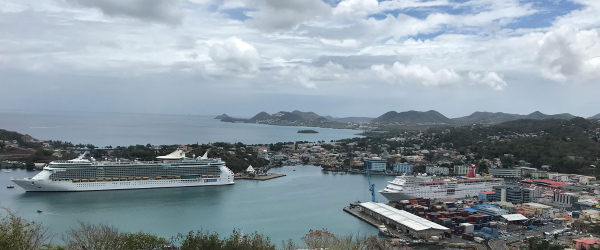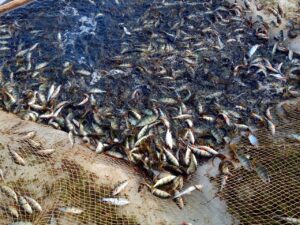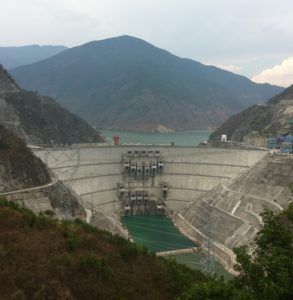
Jack Stuart is a Research Associate with the Environmental Security Program at the Stimson Center. His research focuses on systemic environmental risks, the conflict-climate nexus, and the impact of climate change on coastal cities. He joined Stimson in part because of its focus on the relatively small but growing field of environmental security.
Why is environmental security still considered to be a relatively niche field?
It sits at the intersection of two different communities – the security and the environmental –and policymakers and researchers have at times been slow to connect the two. The security arena traditionally has not focused on environmental factors. It focused on “hard” issues like nuclear nonproliferation – exactly what Stimson focused on when it was founded 30 years ago.
However, this narrow approach tended to discount marginalized and vulnerable communities. It did not take into account that people can be insecure in the country in which they reside, even if that country is considered secure by traditional standards. It also does not consider non-traditional threats such as environmental factors. For example, how natural resource theft, environmental degradation, and the climate crisis threaten ecological, social, and economic security of individual, communities, and nations.
While the amount of research on environmental security has certainly increased, it is still challenging to determine the degree to which environmental risk factors lead to vulnerability, instability, and conflict. The relationship is not linear, and the same environmental impacts can produce very different security outcomes depending on the political conditions.
As these risks grow, there is a debate about whether environmental issues should be framed as security issues. Some argue that this framing can lead to militarized responses. In fact, non-state armed groups and the militaries can increase environmental insecurity – war being an obvious example. However, as environmental threats such as climate change and biodiversity loss continue to increase, leaders need data and analysis which integrate environmental factors into their decision making. All stakeholders, governments (including the military), civil society, and the private sector need to work together and build resilient solutions.
What is something people should understand about your work?
Environmental factors are critical to understanding peace and conflict in the twenty-first century. However, their importance is not always recognized by the security community. Factors like climate change; wildlife trafficking; and illegal, unregulated, and unreported fishing all influence human insecurity, why people choose to migrate, and international geopolitics. Discounting these issues as less important leads to poor assumptions and flawed strategic assessments.
Conversely, there is also a need to mainstream a security lens in the environmental community. At the end of the day, these problems and multifaceted and interconnected, and there will never be a single actor who can solve them. A security lens can be valuable when trying to build a coalition of NGOs, governments, the private sectors, and international organizations.
What is one thing you are most proud of accomplishing this year?
After a two-year effort, the Environmental Security program launched the Climate and Ocean Risk Vulnerability Index (CORVI) this past June. CORVI is an innovative tool which compares a diverse range of environmental, economic, and political risks to produce a coastal city risk profile. This information can be used by leaders across governments, international organizations, and the private sector to integrate these risks into their decision making, prioritize actions to build resilience, and access climate finance.
Coastal cities are centers of innovation and economic activity. Forty percent of the global population live within 100 km of the coast and coastal cities are among the fastest growing population centers in the world. In fact, 14 of the world’s 17 largest cities are located on a coastline. Think of New York, Lagos, Ho Chi Minh City, Rio de Janeiro, Jakarta, and dozens of cities in China. The list is endless.
However, these cities are among the most exposed places facing the climate crisis. Rising sea levels, extreme weather events, and warming temperatures are amplifying the vulnerability of city residents. At the same time, cities face underlying economic and social concerns, including rapid urbanization, aging infrastructure, and poor governance. Risks outside of the city limits, such as severe droughts and climate-induced migration, also expose coastal cities to additional stressors. Put all of that together, you get a very complex socioeconomic system.
As the impacts of climate change increase, it stresses already overburdened systems and can increase the likelihood of instability. Faced with these multifaceted and non-linear threats, decision makers need granular data to understand these threats and take action. This is exactly what CORVI does.
After successful CORVI risk profiles in Castries, Saint Lucia and Kingston Jamaica, we are now expanding to five additional city assessments in Bangladesh, Fiji, Kenya, Philippines, and Tanzania. The goal of the project is to assess over 100 cities and build a global dataset of risk and resilience information, to help decision makers across the world understand these relative risks and take effective action.
What would you say to the next administration about environmental security?
The United States needs to prioritize environmental security at both the international and domestic level. We need leaders who will work with the scientific community to develop solutions to the most pressing environmental security concerns of our time, such as the climate crisis and biodiversity loss.
As a first priority, the United States needs to rejoin the Paris Climate Agreement, and work with its partners to reduce greenhouse gas emissions and drive much needed investment to the world’s most vulnerable regions. Without such efforts, we will be unable to meet the Sustainable Development Goals. On the domestic front, the US needs to invest in a zero-carbon economy and build resilience to climate-related extreme weather events, such as wildfires and hurricanes. While these changes will invoke costs; the cost of inaction is even greater. For example, it is estimated that every dollar invested by the U.S. federal government before a disaster saves $6 dollars in recovery. As the most active hurricane season on record ends, the need for leadership and targeted investment is more apparent than ever. Ultimately, we need to shift from a reactionary to a preventative mindset. I am hopeful that the new administration can provide the leadership needed for immediate and concerted action.
Follow Jack on Twitter @JackWStuart, and learn more about the Environmental Security program.




